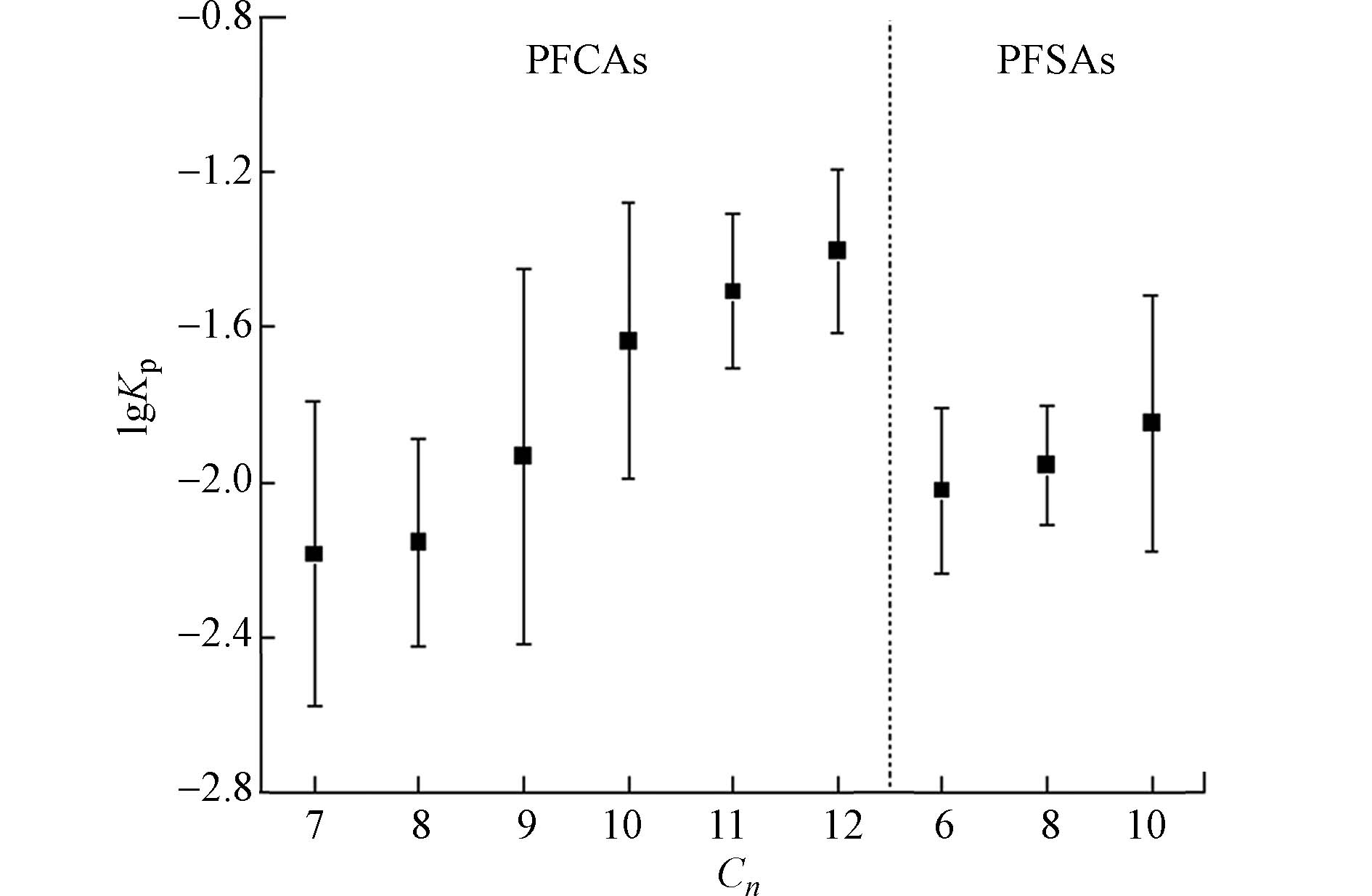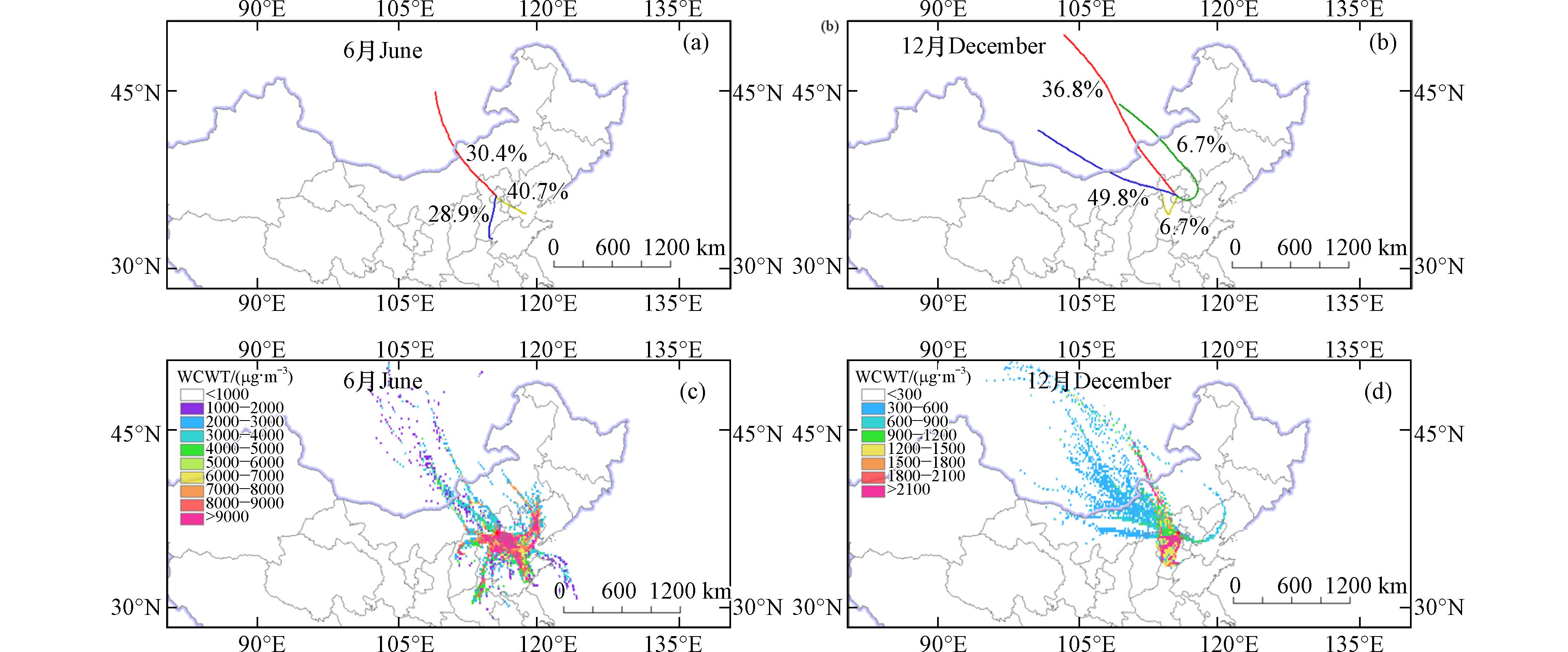-
全氟和多氟烷基化合物(perfluoroalkyl and polyfluoroalkyl substances, PFASs)含有至少一个带有全氟甲基(CF3—)或全氟亚甲基(—CF2—)的碳原子,且该碳原子上不附带任何H/Cl/Br/I[1],其被广泛应用于塑料包装、纸张、涂料、聚四氟乙烯产品和泡沫灭火剂等领域[2 − 4]. 目前PFASs在环境和生物体内均有检出[5 − 8]. 长链PFASs具有高持久性、远距离大气传输潜力、生物蓄积性和毒性,包括≥C7的全氟烷基羧酸(perfluoroalkyl carboxylic acids,PFCAs)和≥C6的全氟烷基磺酸(perfluoroalkane sulfonic acids,PFSAs). 1947年,美国最大的氟化物生产厂家3M公司首次合成全氟辛烷羧酸(perfluorooctanoic acid,PFOA,C8 PFCA),此后,便大量生产和使用PFASs. 由于其对环境和人类健康的危害,3M公司于2002年逐步淘汰全氟辛烷磺酸(perfluorooctane sulfonate acid,PFOS,C8 PFSA)和PFOA的生产和使用,相关的生产产业转移到中国、印度等发展中国家[9 − 10]. 之后,PFOS[11]、PFOA[12]和全氟己烷磺酸(perfluorohexane sulfonate acid,PFHxS,C6 PFSA)[13]、其盐类及其相关化合物先后被列入斯德哥尔摩公约. 2022年,碳链长度在9-21的PFCAs也被提议列入斯德哥尔摩公约[14].
目前对PFASs环境污染特征的研究集中在水体和土壤,有关大气中PFASs的研究相对较少[15 − 16]. 大气是人类生存必不可少的环境,大气传输也是PFASs传输的重要途径之一. PFASs在气相和颗粒相中的分配影响其在大气环境中的存在形式及沉降方式. 然而目前少有监测大气中PFASs的相关研究. 在既有PFASs大气研究中,国外对大气PFASs的研究报道集中在发达国家,例如欧洲西北部[17]、英国[18]、德国[19 − 20]、美国[21 − 22]等,其研究时间多为10年之前甚至更早. 中国对于大气中PFASs的研究集中在近10年内,但相关研究有限,主要研究地点为天津、烟台、厦门等沿海城市[23 − 26]或氟化厂等污染源附近[27],且其中多为颗粒相中PFASs污染特征的研究,关于PFASs气粒分配特征的研究更是不足[23, 28 − 29],缺少对其大气浓度的持续跟踪和监测. 此外,大气沉降是清除大气PFASs的重要途径之一,同时研究大气的干沉降和湿沉降,可以了解大气中PFASs的大气沉降规律. 目前有关PFASs大气沉降通量的研究也较少[26, 30 − 33],且缺少同时分析干沉降通量和湿沉降通量的研究.
PFASs对环境的污染与人类活动密切相关. 北京市常住人口超过2000万,是典型的特大城市,目前有关北京市气粒分配和大气沉降的研究仍有不足. 综上,本研究在北京市设置采样点,分别于2021年6月和12月开展大气观测,研究PFASs在大气中的污染和气粒分配特征,分析了PFASs的潜在来源和干湿沉降规律,并探讨了PFASs的健康影响,以期为大气中PFASs的风险评估和管控提供科学基础和科学依据.
-
本研究的采样时间为2021年6月和12月,采样点为华北电力大学第一教学楼顶(距地面约20 m),分别采用两个串联耦合的环形玻璃扩散管和石英滤膜采集气相和颗粒相样品. 采样前,使用1% Na2CO3和1%甘油-甲醇的混合溶液对环形玻璃管内壁进行涂层以吸附气相PFASs. 每月采集7组样品和3组空白样品,采样时间为48 h,共采集气相和颗粒相样品各14个. 所有样品保存在4 ℃以下,用以检测分析.
-
本研究采用的PFASs混合标准品及混合内标溶液均从加拿大Wellington Laboratories购买,包括全氟庚烷羧酸(perfluoroheptanoic acid,PFHpA,C7 PFCA)、全氟辛烷羧酸(perfluorooctanoic acid,PFOA,C8 PFCA)、全氟壬烷羧酸(perfluorononanoic acid,PFNA,C9 PFCA)、全氟癸烷羧酸(perfluorodecanoic acid,PFDA,C10 PFCA)、全氟十一烷羧酸(perfluoroundecanoic acid,PFUdA,C11 PFCA)、全氟十二烷羧酸(perfluorododecanoic acid,PFDoDA,C12 PFCA)、全氟己烷磺酸(perfluorohexane sulfonate acid,PFHxS,C6 PFSA)、全氟辛烷磺酸(perfluorooctane sulfonate acid,PFOS,C8 PFSA)、全氟癸烷磺酸(perfluorodecane sulfonate acid,PFDS,C10 PFSA). 甲醇(德国CNW)、氨水(德国CNW)和醋酸铵(德国默克集团)均为色谱纯,乙酸从默克集团购买(≥99%),氮气纯度为≥99.999%. Oasis WAX固相萃取柱从美国Waters公司购买(6 mL,150 mg). 超高效液相色谱仪为ACQUITY UPLC® Ⅰ系统(美国Waters公司),串联质谱仪为三重四极杆Xevo TQ-S(美国Waters公司),色谱柱为AQUITY UPLC BEH RP18(1.7 μm,2.1 mm×100 mm,美国Waters公司).
-
样品采集过程结束后,依次用10 mL水、10 mL甲醇和5 mL水/甲醇(V/V, 1/1)旋转振荡环形玻璃管以洗脱气相PFASs. 对于颗粒相PFASs,在洗脱之前先将采样膜剪碎,使用和气相相同的洗脱液,每次洗脱需超声30 min. 之后,使用Oasis WAX萃取小柱进行固相萃取,方法参考Dong等[34],对气相样品和颗粒相样品后续的处理过程完全一致. 在固相萃取之前,依次用4 mL 0.1%的氨-甲醇溶液、4 mL甲醇和4 mL水活化小柱. 样品萃取完成后,用4 mL 0.1%的乙酸溶液对小柱进行酸化处理,之后用6 mL 0.5%的氨-甲醇溶液对目标PFASs进行洗脱,并在40 ℃水浴下将提取液氮吹至约
1000 μL,然后用水/甲醇溶液(V/V, 9/1)将浓缩后的提取液复溶至约250 μL.样品检测的方法参考Dong等[34]. 色谱柱采用AQUITY UPLC BEH RP18,流动相为2 mmol·L−1的乙酸铵溶液和甲醇,流动相流速为0.3 mL·min−1. 洗脱梯度为0 min(10% MeOH),10 min(98% MeOH),13 min(98% MeOH),14 min(10% MeOH),16 min(10% MeOH). Xevo T-QS工作模式为电喷雾电离源.
-
本研究在采样前准备、样品采集、样品分析和数据处理等整个分析过程中,都进行了质量控制和保证. 预处理过程中采用的所有容器和设备在使用前均用甲醇和超纯水进行清洗. 以超纯水作为空白对照,MDL按照所有空白样品中PFASs的平均浓度加5倍检测浓度标准差进行计算. 分析物在气相和颗粒相中的MDL分别为(0.2-5.0) pg·m−3和(0.6-5.6) pg·m−3,平均回收率分别为(104%±5%)至(118%±3%)和(101%±3%)至(108%±1%). 此外,本研究将大气不同浓度(2 ng·L−1、20 ng·L−1)标准品重复测定6次,以反映仪器的精密度.
-
气粒分配系数
$ {K}_{\mathrm{p}} $ (m3·μg−1)采用以下公式进行计算:其中,
$ {C}_{\mathrm{p}} $ 和$ {C}_{\mathrm{g}} $ 分别为PFASs在颗粒相和气相中的浓度(pg·m−3). -
采用HYSPLIT对采样点的PFASs进行后向轨迹分析. 本研究模拟高度为500 m,模拟时间为48 h. 在此基础上结合PFASs浓度数据采用浓度权重轨迹(concentration-weighted trajectory,CWT)模型定性分析PFASs的来源和污染程度. CWT分析通过将研究区域划分为一定分辨率的网格,计算轨迹经过网格时对应点PFASs的平均权重浓度:
其中,
$ {C}_{ij} $ 为网格ij网格中后向轨迹l的平均权重浓度,l为轨迹,$ {C}_{l} $ 为轨迹l经过网格ij对应的PFASs浓度,$ {\tau }_{ij} $ 为轨迹l在网格ij停留的时间,$ {W}_{ij} $ 为权重函数. -
湿沉降通量
$ {F}_{\mathrm{w}\mathrm{e}\mathrm{t}} $ (ng·m−2)采用以下公式进行计算:其中,
$ {p}_{0} $ 为降水量(mm),$ {W}_{\mathrm{g}} $ 和$ {W}_{\mathrm{p}} $ 分别为气相和颗粒相PFASs的冲刷比例. 已有研究中提到$ {W}_{\mathrm{p}} $ 一般在105-106之间[35],本研究中,$ {W}_{\mathrm{p}} $ 取这个范围的中值5×105. Casas等[32]总结了部分POPs的$ {W}_{\mathrm{g}} $ 在90-2×106之间,本研究中,$ {W}_{\mathrm{g}} $ 取这个范围的中值2×104.干沉降通量
$ {F}_{\mathrm{d}\mathrm{r}\mathrm{y}} $ (ng·m−2)采用以下公式进行计算:其中,
$ {v}_{\mathrm{g}} $ 和$ {v}_{\mathrm{p}} $ 分别为气相和颗粒相PFASs的干沉降速率(m·s−1).$ {v}_{\mathrm{p}} $ 一般取值为0.2 cm·s−1[36 − 37],本研究中也采用0.2 cm·s−1. Zhao等[31]计算FTOHs等前体物的$ {v}_{\mathrm{g}} $ 在0.07-1.4 cm·s−1之间,Wu等[38]在计算TFA的干沉降通量时,$ {v}_{\mathrm{g}} $ 取值为0.5 cm·s−1. 本研究$ {v}_{\mathrm{g}} $ 也取值0.5 cm·s−1. -
大气中的PFASs可以通过呼吸道、吸入和皮肤接触3种途径进入人体,以上3种途径的人体每日平均暴露量分别用以下式子进行计算:
其中,
$ {\mathrm{A}\mathrm{D}\mathrm{D}}_{\mathrm{i}\mathrm{n}\mathrm{h}} $ 为呼吸道途径的人体每日摄入量(ng·kg−1·d−1),$ {\mathrm{A}\mathrm{D}\mathrm{D}}_{\mathrm{i}\mathrm{n}\mathrm{g}} $ 为吸入途径的人体每日摄入量(ng·kg−1·d−1),$ {\mathrm{A}\mathrm{D}\mathrm{D}}_{\mathrm{d}\mathrm{e}\mathrm{r}} $ 为皮肤接触途径的人体每日摄入量(ng·kg−1·d−1),暴露时间$ \mathrm{E}\mathrm{D} $ (a)、暴露频率$ \mathrm{E}\mathrm{F} $ (d·a−1)、体重$ \mathrm{B}\mathrm{W} $ (kg)和终身暴露时间$ \mathrm{A}\mathrm{T} $ (d)分别采用Liu等[24]、Sánchez-Piñero等[40]、Xu等[41]和USEPA[39]的值,呼吸率$ \mathrm{I}\mathrm{R} $ (m3·d−1)采用《中国人群暴露参数手册(儿童卷:6—17岁)》[42]和《中国人群暴露参数手册(成人卷)》[43]的值,吸入率$ \mathrm{S}\mathrm{R}\mathrm{I} $ (mg·d−1)和皮肤吸收因子$ \mathrm{A}\mathrm{B}\mathrm{F} $ 参考Shi等[44],皮肤暴露表面积$ \mathrm{S}\mathrm{A} $ (cm2)、皮肤黏着度$ \mathrm{A}\mathrm{F} $ (mg·m2·d−1)和转化速率常数$ \mathrm{C}\mathrm{F} $ (kg·mg−1)参考Li等[45]. -
大气中PFASs总浓度为(166.75±101.67) pg·m−3,气相和颗粒相浓度分别为(130.84±92.01) pg·m−3和(35.91±17.28) pg·m−3,气相PFASs浓度高于颗粒相(表1),占大气总浓度的78.46%. 在气相和颗粒相中,PFOA平均浓度的占比均是最高的,分别为37.44%和36.70%. 其次是PFHpA,其在气相和颗粒相中的占比分别为36.39%和24.69%. 以上物质均为PFCAs. 在PFSAs中,PFOS对PFSAs气相总浓度的贡献是最大的,为47.90%,而在颗粒相中,PFDS的贡献是最大的,为38.48%. 本研究PFASs气相总浓度高于已有研究的观测值(0.72-62.30 pg·m−3)[23, 28, 46 − 47],主要是因为PFHpA((47.61±40.40) pg·m−3)和PFOA的浓度((49.00±32.26) pg·m−3)高于已有文献值(0.1-20 pg·m−3)[28, 46 − 47],本研究其他物质的总浓度((34.24±21.25) pg·m−3)和已有文献值相差不大(0.12-38.61 pg·m−3)[23, 28, 46 − 47]. 颗粒相中,PFASs的浓度和已有报道值相差不大(1.20-32.48 pg·m−3)[28 − 29, 46, 48 − 49],但低于2014年环渤海城市的观测值(311.33-564.90 pg·m−3)[23].
PFASs在气相和颗粒相中的浓度均为6月高于12月. 6月,大气中臭氧浓度较高且光照较强,说明大气氧化性也较强,在这种条件下将可能会有更多的前体物氧化降解生成PFASs,进而导致PFASs浓度的增加[50]. 此外,6月温度较高,前体物的挥发性更强,可能会降解生成更多的PFASs.
本研究计算了PFASs在气相和颗粒相之间的分配系数
$ {K}_{\mathrm{p}} $ . 本研究各PFASs的$ \mathrm{lg}{K}_{\mathrm{p}} $ 为−2.18—−1.40,与2013年北京(−2.1—−1.9)[28]的研究结果在同一量级,和2010年加拿大(−2.43—−1.42)[51],以及2013-2015年巢湖(−1.91—−1.34)[46]的研究结果相差不大. 从图1可以看出,碳链越长的PFASs,气粒分配系数越大,更多地分配在颗粒相中,且气粒分配系数的对数和碳链长度呈现显著的正相关(P<0.01). -
本研究采用后向轨迹模型模拟采样点上空气团的传输轨迹,结果如图2(a)和(b)所示. 6月,气团主要来自采样点的东南方向(40.7%),主要受到天津的影响,该轨迹上∑PFASs的浓度((127.19±122.49) pg·m−3)也是最高的. 来自采样点西南方向的气团比例相对最小(28.9%),该气团上的PFASs浓度为(73.31±45.66) pg·m−3,主要受到河北南部大气传输的影响. 还有一部分气团(30.4%)自北京的西北方经过内蒙古和河北张家口达到采样点,该气团轨迹线较长,表明大气扩散条件较好,气团上PFASs的浓度也是相对最低的((21.33±14.23) pg·m−3). 与6月不同,12月采样点上空的气团均主要来自其西北方(93.3%),主要受到内蒙古和河北张家口远距离大气传输的影响. 这3条气团轨迹上∑PFASs的平均浓度为(25.03±18.94) pg·m−3. 还有6.7%的气团受到河北近距离大气传输的影响,该气团上∑PFASs浓度为(48.86±16.18) pg·m−3.
在后向轨迹结果的基础上,进一步用浓度权重轨迹(CWT)分析PFASs的来源和区域污染程度,结果如图2(c)和(d)所示,不同气团轨迹对大气中PFASs的贡献浓度以WCWT表示. 6月,浓度权重较大的地区为天津,天津有较多的纺织和电氟化学等相关氟化工业[52],浓度较高可能是因为受到氟化工厂的污染[24]. 聚类结果表明,来自该方向的气团上∑PFASs的浓度占比也是相对较高的(57.34%). 12月,河北中部对采样点大气PFASs污染的贡献较大,来自该方向的气团上∑PFASs的浓度也是最高的,对12月PFASs总浓度的贡献为39.41%. 此外,贡献较大的地区呈带状分布在内蒙古,对采样点大气的PFASs污染也有所贡献. 以上CWT结果均和后向轨迹结果一致. 需要说明的是,本研究关于大气中PFASs的来源主要探讨了其大气远距离传输的区域. 除此之外,水体、土壤和植物中的PFASs也会扩散到大气中,未来有必要对上述潜在来源做进一步的量化分析.
根据大气浓度计算采样点的沉降通量. PFASs的总沉降通量为(2.14±0.68) ng·m−2,其中干沉降通量为(2.02±0.65) ng·m−2,对总沉降通量的贡献(以下称“干沉降的相对贡献”)为94.51%,显著高于湿沉降通量((0.12±0.08) ng·m−2,5.49%). 研究期间,各PFASs的沉降方式均以干沉降为主,干沉降的相对贡献均大于90%. 从季节来看,6月的干沉降通量((2.50±1.52) ng·m−2)和湿沉降通量((0.20±0.13) ng·m−2)均大于12月(干沉降通量为(1.58±0.52) ng·m−2,湿沉降通量为(4.81×10−3±2.62×10−3) ng·m−2). 一方面可能是因为6月PFASs气相和颗粒相浓度均高于12月,另一方面可能是6月的沉降量(67.2 mm)大于12月(2.3 mm).
-
大气中的PFASs会通过呼吸道、吸入和皮肤接触3种途径进入人体内,当其在人体内的浓度达到一定阈值,可能会对人体的健康造成一定的毒性危害[53]. 采样点大气中∑PFASs的人体每日摄入量和风险值见表2. 儿童的人体每日摄入总量(1.45-46.45 ng·kg−1·d−1)约为成人(0.23-7.31 ng·kg−1·d−1)的6倍. 其中,儿童∑PFASs的
$ {\mathrm{A}\mathrm{D}\mathrm{D}}_{\mathrm{i}\mathrm{n}\mathrm{h}} $ 、$ {\mathrm{A}\mathrm{D}\mathrm{D}}_{\mathrm{i}\mathrm{n}\mathrm{g}} $ 和$ {\mathrm{A}\mathrm{D}\mathrm{D}}_{\mathrm{d}\mathrm{e}\mathrm{r}} $ 分别为成人的2倍、6倍和4倍,可能是因为儿童的体重较低. 此外,儿童的吸入率和皮肤黏着度也较成人高. 在3种暴露途径中,吸入是最主要的途径,因此应该重视吸入对人体产生的健康影响. 儿童通过吸入途径接触PFASs的风险(98.95%)较成人(97.24%)稍高,通过呼吸道接触PFASs的风险(0.78%)较成人(2.37%)稍低,皮肤接触途径对于儿童和成人的暴露风险均小于1%.值得注意的是,除了环境大气,PFASs还可通过食物和饮用水进入人体,且有研究表明,在PFASs的不同暴露途径中,摄食是最主要的暴露途径,环境大气途径对人体暴露的贡献是最小的[4, 54]. 人体接触PFASs的途径多种多样,PFASs对人体的健康风险也是综合且复杂的[55 − 56]. 污染物对人体的健康风险不是单一的加和作用,而是不同化合物的协同作用,其对人体的健康风险可能比估算值高得多. 此外,本研究只采集了PM2.5,尽管已有研究结果显示,PFCAs多存在于细颗粒上,但PFSAs多存在于粗颗粒上[26],不可忽视粗颗粒上的PFASs对人体的健康风险. 综上,PFASs对人体的健康风险值得持续关注.
-
(1)研究期间,采样点大气PFASs浓度为(166.75±101.67) pg·m−3,气相PFASs对大气总浓度的贡献为78.46%. 在气相和颗粒相中,PFOA均是主要物质,其次为PFHpA. PFASs的气粒分配系数随碳链增加而增加,且其对数和碳链长度呈现显著正相关.
(2)在6月,气团主要来自东南方向,该气团上PFASs的浓度相对最高,主要受到河北南部大气传输的影响. 12月,气团主要来自北京西北方向的河北西北部和内蒙古,但来自河北中部的气团上PFASs的浓度是相对最高的. 研究期间,采样点大气中各PFASs的沉降方式均以干沉降为主.
(3)健康风险分析结果表明,在研究期间,采样点的大气PFASs的三种暴露途径中,吸入是最主要的途径,儿童的人体每日摄入量均高于成人.
大气中部分全氟和多氟烷基化合物的污染特征、大气来源区域及健康影响
Pollution characteristics, atmospheric source regions, and health risk of partial perfluorinated and polyfluoroalkyl substances in the atmosphere
-
摘要: 全氟和多氟烷基化合物(perfluoroalkyl and polyfluoroalkyl substances,PFASs)是一类新污染物,近年来受到国际的广泛关注. 目前有关PFASs的研究多集中在水体和土壤,有关大气中PFASs的研究较为有限,其中有关中国大气PFASs的研究更少,且多集中在颗粒相. 本研究在北京市设置1个采样点,于2021年6月和12月同步采集气相和颗粒相样品,并采用超高效液相色谱串联质谱仪(UPLC-MS/MS)对9种PFASs进行检测分析,研究大气中PFASs的浓度水平和气粒分配特征,并探讨其来源、归趋和健康影响. 结果显示,PFASs的总浓度为(166.75±101.67) pg·m−3,气相浓度((130.84±92.01) pg·m−3)高于颗粒相((35.91±17.28) pg·m−3),对气相和颗粒相PFASs浓度贡献最大的物质均为PFOA. PFASs碳链越长,其气粒分配系数越大,会更多地分配在颗粒相中,气粒分配系数的对数和碳链长度呈现显著正相关. 采样点的PFASs主要受来自北京周边的天津市、河北省和内蒙古自治区大气传输的影响,干沉降是其主要的大气沉降方式.Abstract: Perfluoroalkyl and polyfluoroalkyl substances (PFASs) are emerging pollutants by international concern in recent years. To data, research on PFASs mainly focus on water and soil, while research on PFASs in the atmosphere are relatively fewer. Among them, there is even less research on PFASs in the atmosphere in China, and most of them are focused on the particle phase. This study set up a sampling point in Beijing and simultaneously collected gas phase and particle phase samples in June and December 2021. Ultra-performance liquid chromatography tandem mass spectrometry (UPLC-MS/MS) was used to detect and analyze 9 PFASs. The concentrations and gas-particle partitioning characteristics of PFASs in the atmosphere were studied, and their sources, fate, and health risk were analyzed. The results showed that the total concentration of PFASs was (166.75±101.67) pg·m−3, and the gas phase concentration with (130.84±92.01) pg·m−3 was higher than of the particle phase with (35.91±17.28) pg·m−3. PFOA contributed the most to the concentration of PFASs in both the gas phase and the particle phase. The longer the carbon chain of PFASs, the greater their gas-particle partitioning coefficients, which can be more distributed in the particle phase. The logarithm of the gas-particle partitioning coefficient is significantly positively correlated with the length of the carbon chain. The PFASs of sampling points were mainly affected by atmospheric transport from Tianjin, Hebei Province, and Inner Mongolia Autonomous Region around Beijing. Dry deposition was dominant in the atmospheric deposition of each PFAS.
-
Key words:
- PFASs /
- atmosphere /
- pollution characteristics /
- source analysis /
- health risk.
-

-
表 1 气相和颗粒相中PFASs的浓度(pg·m−3)
Table 1. Concentrations of PFASs in the gas phase and the particle phase(pg·m−3)
物质
Substance6月
June12月
December气相
Gas phase颗粒相
Particle phase气相
Gas phase颗粒相
Particle phasePFHpA 89.79±59.17 14.82±18.28 5.43±2.72 6.55±3.88 PFOA 47.95±42.71 11.07±10.44 50.04±20.70 20.68±19.95 PFNA 20.80±13.71 8.21±4.72 4.98±3.65 1.12±0.82 PFDA 3.39±2.95 6.52±3.14 0.91±1.83 0.30±0.79 PFUdA 3.57±1.76 6.16±3.54 4.30±2.71 1.26±2.46 PFDoDA 3.13±2.04 4.02±2.04 2.49±1.12 0.52±1.84 PFHxS 0.98±0.61 0.09±0.24 3.62±1.33 1.19±0.23 PFOS 1.52±0.33 0.71±1.11 10.41±5.65 1.26±0.47 PFDS 0.45±0.52 1.07±0.86 7.92±9.31 0.97±0.30 表 2 呼吸道、吸入和皮肤接触3种途径摄入北京市PFASs的人体每日摄入量(×10−2 ng·kg−1·d−1)
Table 2. Average daily dose of PFASs in Beijing via ingestion, inhalation, and skin contact (×10−2 ng·kg−1·d−1)
物质
Substance儿童
Children成人
Adults$ {\mathrm{A}\mathrm{D}\mathrm{D}}_{\mathrm{i}\mathrm{n}\mathrm{h}} $ $ {\mathrm{A}\mathrm{D}\mathrm{D}}_{\mathrm{i}\mathrm{n}\mathrm{g}} $ $ {\mathrm{A}\mathrm{D}\mathrm{D}}_{\mathrm{d}\mathrm{e}\mathrm{r}} $ $ {\mathrm{A}\mathrm{D}\mathrm{D}}_{\mathrm{i}\mathrm{n}\mathrm{h}} $ $ {\mathrm{A}\mathrm{D}\mathrm{D}}_{\mathrm{i}\mathrm{n}\mathrm{g}} $ $ {\mathrm{A}\mathrm{D}\mathrm{D}}_{\mathrm{d}\mathrm{e}\mathrm{r}} $ PFHpA 2.94 276.52 0.77 1.42 42.95 0.17 PFOA 3.27 410.93 1.15 1.58 63.83 0.25 PFNA 0.89 120.74 0.34 0.43 18.76 0.07 PFDA 0.28 88.19 0.25 0.14 13.7 0.05 PFUdA 0.39 96.09 0.27 0.19 14.93 0.06 PFDoDA 0.26 58.73 0.16 0.12 9.12 0.04 PFHxS 0.15 16.56 0.05 0.07 2.57 0.01 PFOS 0.35 25.61 0.07 0.17 3.98 0.02 PFDS 0.26 26.38 0.07 0.13 4.10 0.02 -
[1] ECHA. ANNEX XV RESTRICTION REPORT – Per- and polyfluoroalkyl substances (PFASs) [EB/OL]. [2023-12-4]. 2023. [2] 金梦, 刘丽君, 赵波, 等. 长三角地区水体中全氟化合物的污染特征及风险评价[J]. 环境化学, 2023, 42(7): 2153-2162. doi: 10.7524/j.issn.0254-6108.2022022002 JIN M, LIU L J, ZHAO B, et al. Pollution characteristics and risk assessment of perfluoroalkyl substances in surface water from Yangtze River Delta[J]. Environmental Chemistry, 2023, 42(7): 2153-2162 (in Chinese). doi: 10.7524/j.issn.0254-6108.2022022002
[3] 周龙飞, 陈文静, 张扬, 等. 太湖梅梁湾水环境中全氟和多氟化合物的污染特征及风险评估[J]. 环境化学, 2023, 42(10): 3408-3419. doi: 10.7524/j.issn.0254-6108.2022042403 ZHOU L F, CHEN W J, ZHANG Y, et al. Pollution characteristics and risk assessment of per-and polyfluoroalkyl substances in waters of Meiliang Bay, Taihu Lake[J]. Environmental Chemistry, 2023, 42(10): 3408-3419 (in Chinese). doi: 10.7524/j.issn.0254-6108.2022042403
[4] 温祥洁, 王若男, 钟亚萍, 等. 成都市某工业园区及周围表层土壤中全氟化合物的分布特征与风险评估[J]. 环境化学, 2024, 43(4): 1292-1303. doi: 10.7524/j.issn.0254-6108.2022101104 WEN X J, WANG R N, ZHONG Y P, et al. Distribution characteristics and risk assessment of perfluoroalkyl substances in surface soils in and around an industrial park in Chengdu[J]. Environmental Chemistry, 2024, 43(4): 1292-1303(in Chinese). doi: 10.7524/j.issn.0254-6108.2022101104
[5] TIAN Y, YAO Y M, CHANG S, et al. Occurrence and phase distribution of neutral and ionizable per- and polyfluoroalkyl substances (PFASs) in the atmosphere and plant leaves around landfills: A case study in Tianjin, China[J]. Environmental Science & Technology, 2018, 52(3): 1301-1310. [6] SUN J C, LETCHER R J, EENS M, et al. Perfluoroalkyl acids and sulfonamides and dietary, biological and ecological associations in peregrine falcons from the Laurentian Great Lakes Basin, Canada[J]. Environmental Research, 2020, 191: 110151. doi: 10.1016/j.envres.2020.110151 [7] KURWADKAR S, DANE J, KANEL S R, et al. Per- and polyfluoroalkyl substances in water and wastewater: A critical review of their global occurrence and distribution[J]. Science of the Total Environment, 2022, 809: 151003. doi: 10.1016/j.scitotenv.2021.151003 [8] ROSATO I, ZARE JEDDI M, LEDDA C, et al. How to investigate human health effects related to exposure to mixtures of per- and polyfluoroalkyl substances: A systematic review of statistical methods[J]. Environmental Research, 2022, 205: 112565. doi: 10.1016/j.envres.2021.112565 [9] 曾士宜, 杨鸿波, 彭洁, 等. 贵州草海湖泊表层水与沉积物中全氟化合物的污染特征及风险评估[J]. 环境化学, 2021, 40(4): 1193-1205. doi: 10.7524/j.issn.0254-6108.2020072404 ZENG S Y, YANG H B, PENG J, et al. Pollution characteristics and risk assessment of perfluorinated compounds in surface water and sediments of Caohai Lake of Guizhou Province[J]. Environmental Chemistry, 2021, 40(4): 1193-1205 (in Chinese). doi: 10.7524/j.issn.0254-6108.2020072404
[10] 雷梦真, 何锦秋, 张洪利, 等. 成都市典型湿地公园全氟化合物的污染特征及风险评估[J]. 环境化学, 2024, 43(9): 3043-3053. doi: 10.7524/j.issn.0254-6108.2023031801 LEI M Z, HE J Q, ZHANG H L, et al. Pollution characteristics and risk assessment of perfluoroalkyl substances in the typical wetland of Chengdu City[J]. Environmental Chemistry, 2024, 43(9): 3043-3053(in Chinese). doi: 10.7524/j.issn.0254-6108.2023031801
[11] UNEP. Addendum to the risk management evaluation for perfluorooctane sulfonate[EB/OL]. [2023-12-4]. 2008, [12] UNEP. Addendum to the risk management evaluation on perfluorooctanoic acid (PFOA), its salts and PFOA-related compounds[EB/OL]. [2023-12-4]. 2018, [13] UNEP. Risk management evaluation on perfluorohexane sulfonic acid (PFHxS), its salts and PFHxS-related compounds[EB/OL]. [2023-12-4]. 2019, [14] UNEP. Proposal to list long-chain perfluorocarboxylic acids, their salts and related compounds in Annexes A, B and/or C to the Stockholm Convention on Persistent Organic Pollutants[EB/OL]. [2023-12-4]. 2022, [15] LIU W X, WU J Y, HE W, et al. A review on perfluoroalkyl acids studies: Environmental behaviors, toxic effects, and ecological and health risks[J]. Ecosystem Health and Sustainability, 2019, 5(1): 1558031. [16] CHENG B, ALAPATY K, ZARTARIAN V, et al. Per- and polyfluoroalkyl substances exposure science: current knowledge, information needs, future directions[J]. International Journal of Environmental Science and Technology, 2021, 19(10): 10393-13408. [17] BARBER J L, BERGER U, CHAEMFA C, et al. Analysis of per- and polyfluorinated alkyl substances in air samples from Northwest Europe[J]. Journal of Environmental Monitoring: JEM, 2007, 9(6): 530-541. doi: 10.1039/b701417a [18] GOOSEY E, HARRAD S. Perfluoroalkyl substances in UK indoor and outdoor air: Spatial and seasonal variation, and implications for human exposure[J]. Environment International, 2012, 45: 86-90. doi: 10.1016/j.envint.2012.04.007 [19] XIE Z Y, ZHAO Z, MÖLLER A, et al. Neutral poly- and perfluoroalkyl substances in air and seawater of the North Sea[J]. Environmental Science and Pollution Research, 2013, 20(11): 7988-8000. doi: 10.1007/s11356-013-1757-z [20] WANG Z, XIE Z Y, MÖLLER A, et al. Atmospheric concentrations and gas/particle partitioning of neutral poly- and perfluoroalkyl substances in northern German coast[J]. Atmospheric Environment, 2014, 95: 207-213. doi: 10.1016/j.atmosenv.2014.06.036 [21] KIM S K, KANNAN K. Perfluorinated acids in air, rain, snow, surface runoff, and lakes: Relative importance of pathways to contamination of urban lakes[J]. Environmental Science & Technology, 2007, 41(24): 8328-8334. [22] SHIN H M, VIEIRA V M, RYAN P B, et al. Environmental fate and transport modeling for perfluorooctanoic acid emitted from the Washington Works Facility in West Virginia[J]. Environmental Science & Technology, 2011, 45(4): 1435-1442. [23] YAO Y M, CHANG S, ZHAO Y Y, et al. Per- and poly-fluoroalkyl substances (PFASs) in the urban, industrial, and background atmosphere of Northeastern China coast around the Bohai Sea: Occurrence, partitioning, and seasonal variation[J]. Atmospheric Environment, 2017, 167: 150-158. doi: 10.1016/j.atmosenv.2017.08.023 [24] LIU Y, LIU W J, XU Y S, et al. Characteristics and human inhalation exposure of ionic per- and polyfluoroalkyl substances (PFASs) in PM10 of cities around the Bohai Sea: Diurnal variation and effects of heating activity[J]. The Science of the Total Environment, 2019, 687: 177-187. doi: 10.1016/j.scitotenv.2019.06.103 [25] YAMAZAKI E, TANIYASU S, WANG X H, et al. Per- and polyfluoroalkyl substances in surface water, gas and particle in open ocean and coastal environment[J]. Chemosphere, 2021, 272: 129869. doi: 10.1016/j.chemosphere.2021.129869 [26] WANG S Q, LIN X P, LI Q, et al. Particle size distribution, wet deposition and scavenging effect of per- and polyfluoroalkyl substances (PFASs) in the atmosphere from a subtropical city of China[J]. Science of the Total Environment, 2022, 823: 153528. doi: 10.1016/j.scitotenv.2022.153528 [27] ZHAO N, ZHAO M R, LIU W P, et al. Atmospheric particulate represents a source of C8–C12 perfluoroalkyl carboxylates and 10: 2 fluorotelomer alcohol in tree bark[J]. Environmental Pollution, 2021, 273: 116475. doi: 10.1016/j.envpol.2021.116475 [28] WU J, JIN H B, LI L, et al. Atmospheric perfluoroalkyl acid occurrence and isomer profiles in Beijing, China[J]. Environmental Pollution, 2019, 255: 113129. doi: 10.1016/j.envpol.2019.113129 [29] FANG X G, WANG Q, ZHAO Z, et al. Distribution and dry deposition of alternative and legacy perfluoroalkyl and polyfluoroalkyl substances in the air above the Bohai and Yellow Seas, China[J]. Atmospheric Environment, 2018, 192: 128-135. doi: 10.1016/j.atmosenv.2018.08.052 [30] WANG Z, XIE Z Y, MÖLLER A, et al. Estimating dry deposition and gas/particle partition coefficients of neutral poly-/perfluoroalkyl substances in northern German coast[J]. Environmental Pollution, 2015, 202: 120-125. doi: 10.1016/j.envpol.2015.03.029 [31] ZHAO Z, TANG J H, MI L J, et al. Perfluoroalkyl and polyfluoroalkyl substances in the lower atmosphere and surface waters of the Chinese Bohai Sea, Yellow Sea, and Yangtze River Estuary[J]. Science of the Total Environment, 2017, 599/600: 114-123. doi: 10.1016/j.scitotenv.2017.04.147 [32] CASAS G, MARTINEZ-VARELA A, VILA-COSTA M, et al. Rain amplification of persistent organic pollutants[J]. Environmental Science & Technology, 2021, 55(19): 12961-12972. [33] WANG F W, WANG W R, ZHAO D Y, et al. Source apportionment and wet deposition of atmospheric poly- and per-fluoroalkyl substances in a metropolitan city centre of southwest China[J]. Atmospheric Environment, 2022, 273: 118983. doi: 10.1016/j.atmosenv.2022.118983 [34] DONG B Q, WU J, ZHUANG Y R, et al. Trace analysis method based on UPLC-MS/MS for the determination of (C2-C18) per-and polyfluoroalkyl substances and its application to tap water and bottled water[J]. Analytical Chemistry, 2023, 95(2): 695-702. [35] BIDLEMAN T, HARNER T. Handbook of property estimation methods for chemicals[M]. Boca Raton, FL: Lewis Publ, 2000 [36] MILLER S M, GREEN M L, DEPINTO J V, et al. Results from the Lake Michigan Mass Balance study: Concentrations and fluxes of atmospheric polychlorinated biphenyls and trans-nonachlor[J]. Environmental Science & Technology, 2001, 35(2): 278-285. [37] GIGLIOTTI C L, TOTTEN L A, OFFENBERG J H, et al. Atmospheric concentrations and deposition of polycyclic aromatic hydrocarbons to the Mid-Atlantic East Coast Region[J]. Environmental Science & Technology, 2005, 39(15): 5550-5559. [38] WU J, MARTIN J W, ZHAI Z H, et al. Airborne trifluoroacetic acid and its fraction from the degradation of HFC-134a in Beijing, China[J]. Environmental Science & Technology, 2014, 48(7): 3675-3681. [39] USEPA. Risk Assessment guidance for superfund volume Ⅰ: Human health evaluation manual (Part E, Supplemental guidance for dermal risk assessment)[R]. 2004. [40] SÁNCHEZ-PIÑERO J, NOVO-QUIZA N, PERNAS-CASTAÑO C, et al. Inhalation bioaccessibility of multi-class organic pollutants associated to atmospheric PM2.5: Correlation with PM2.5 properties and health risk assessment[J]. Environmental Pollution, 2022, 307: 119577. doi: 10.1016/j.envpol.2022.119577 [41] XU Z J, ZHU H B, SHU L Y, et al. Estimation of the fraction of soil-borne particulates in indoor air by PMF and its impact on health risk assessment of soil contamination in Guangzhou, China[J]. Environmental Pollution, 2022, 308: 119623. doi: 10.1016/j.envpol.2022.119623 [42] 中华人民共和国生态环境部. 中国人群暴露参数手册(儿童卷: 6—17岁)[M]. 北京: 中国环境出版社, 2016. Ministry of Environmental Protection of the People's Republic of China. Exposure factors handbook of Chinese population (Children: 6—17 years old)[M]. Beijing: China Environmental Science Press, 2016 (in Chinese).
[43] 中华人民共和国生态环境部. 中国人口暴露因素手册(成人)[M]. 北京: 中国环境出版社, 2013. Ministry of Environmental Protection of the People's Republic of China. Exposure factors handbook of Chinese population (Adult)[M]. Beijing: China Environmental Science Press, 2013 (in Chinese).
[44] SHI G T, CHEN Z L, BI C J, et al. A comparative study of health risk of potentially toxic metals in urban and suburban road dust in the most populated city of China[J]. Atmospheric Environment, 2011, 45(3): 764-771. doi: 10.1016/j.atmosenv.2010.08.039 [45] LI J F, ZHANG Z Z, MA L Y, et al. Implementation of USEPA RfD and SFO for improved risk assessment of organophosphate esters (organophosphate flame retardants and plasticizers)[J]. Environment International, 2018, 114: 21-26. doi: 10.1016/j.envint.2018.02.027 [46] LIU W X, HE W, WU J Y, et al. Distribution, partitioning and inhalation exposure of perfluoroalkyl acids (PFAAs) in urban and rural air near Lake Chaohu, China[J]. Environmental Pollution, 2018, 243: 143-151. doi: 10.1016/j.envpol.2018.08.052 [47] HAN D M, MA Y G, HUANG C, et al. Occurrence and source apportionment of perfluoroalkyl acids (PFAAs) in the atmosphere in China[J]. Atmospheric Chemistry and Physics, 2019, 19(22): 14107-14117. doi: 10.5194/acp-19-14107-2019 [48] MÜLLER C E, GERECKE A C, BOGDAL C, et al. Atmospheric fate of poly- and perfluorinated alkyl substances (PFASs): I. Day-night patterns of air concentrations in summer in Zurich, Switzerland[J]. Environmental Pollution, 2012, 169: 196-203. doi: 10.1016/j.envpol.2012.04.010 [49] 李孝通, 王媛, 史亚利, 等. 固相萃取-高效液相色谱-串联质谱法测定大气细颗粒物中全氟/多氟化合物[J]. 环境化学, 2023, 42(2): 399-408. doi: 10.7524/j.issn.0254-6108.2021100803 LI X T, WANG Y, SHI Y L, et al. Determination of per- and polyfluoroalkyl substances in PM2.5 by high performance liquid chromatography-tandem mass spectrometry combined with solid phase extraction[J]. Environmental Chemistry, 2023, 42(2): 399-408 (in Chinese). doi: 10.7524/j.issn.0254-6108.2021100803
[50] THACKRAY C P, SELIN N E, YOUNG C J. A global atmospheric chemistry model for the fate and transport of PFCAs and their precursors[J]. Environmental Science: Processes & Impacts, 2020, 22(2): 285-293. [51] AHRENS L, HARNER T, SHOEIB M, et al. Improved characterization of gas-particle partitioning for per- and polyfluoroalkyl substances in the atmosphere using annular diffusion denuder samplers[J]. Environmental Science & Technology, 2012, 46(13): 7199-7206. [52] ZHAO L J, ZHOU M, ZHANG T, et al. Polyfluorinated and perfluorinated chemicals in precipitation and runoff from cities across eastern and central China[J]. Archives of Environmental Contamination and Toxicology, 2013, 64(2): 198-207. doi: 10.1007/s00244-012-9832-x [53] 张美, 楼巧婷, 邵倩文, 等. 全氟化合物污染现状及风险评估的研究进展[J]. 生态毒理学报, 2019, 14(3): 30-53. ZHANG M, LOU Q T, SHAO Q W, et al. Research progress of perfluorinated compounds pollution status and risk assessment[J]. Asian Journal of Ecotoxicology, 2019, 14(3): 30-53 (in Chinese).
[54] SHOEIB T, HASSAN Y, RAUERT C, et al. Poly- and perfluoroalkyl substances (PFASs) in indoor dust and food packaging materials in Egypt: Trends in developed and developing countries[J]. Chemosphere, 2016, 144: 1573-1581. doi: 10.1016/j.chemosphere.2015.08.066 [55] 姚谦, 田英. 中国人群全氟化合物健康风险评估研究进展[J]. 上海交通大学学报(医学版), 2021, 41(6): 803-808. YAO Q, TIAN Y. Research progress in health risk assessment of perfluorinated compounds among Chinese population[J]. Journal of Shanghai Jiao Tong University (Medical Science), 2021, 41(6): 803-808 (in Chinese).
[56] 范雨晴, 王雄, 陈铭杰, 等. 全氟和多氟烷基物质在北部湾海域表层沉积物中的污染特征及风险评估[J]. 环境化学, 2023, 42(3): 873-883. doi: 10.7524/j.issn.0254-6108.2022070804 FAN Y Q, WANG X, CHEN M J, et al. Pollution characteristics and risk assessment of perfluoroalkyl substances in surface sediments of the Beibu Gulf[J]. Environmental Chemistry, 2023, 42(3): 873-883 (in Chinese). doi: 10.7524/j.issn.0254-6108.2022070804
-




 下载:
下载:




























































